Introduction to Post Office Protocol
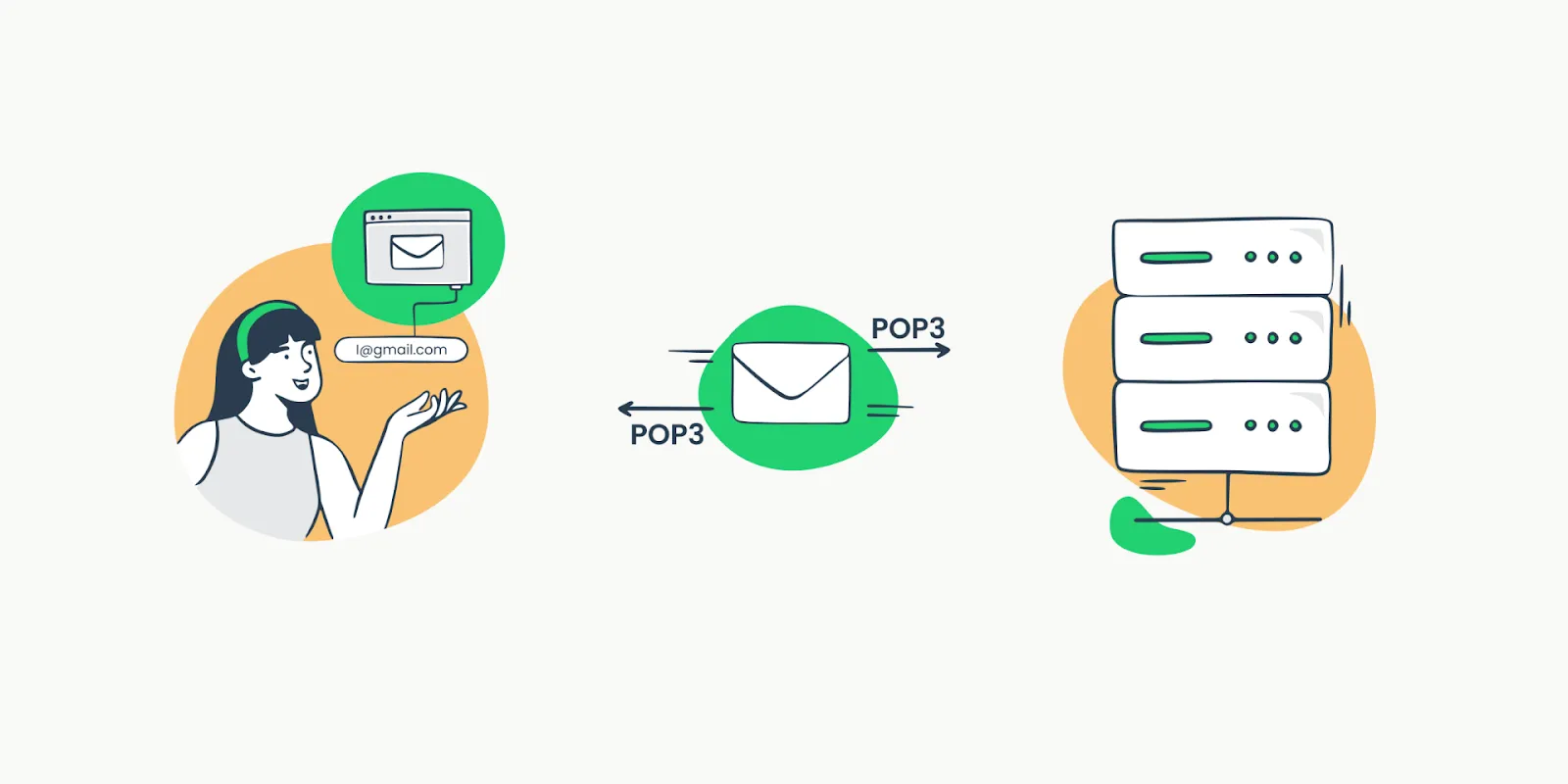
POP stands for "Post Office Protocol." It is a protocol used by email clients to retrieve emails from a mail server over an Internet connection. This protocol serves as a key bridge between the server where your emails are stored and your personal email software, ensuring seamless access to your messages."
What is Post Office Protocol Version 3
POP3 stands for Post Office Protocol version 3, which is the latest and most advanced version of the POP Protocol.
Compared to its earlier versions, POP1 and POP2, POP3 has incorporated several improvements such as better error handling, more efficient message retrieval mechanisms, and standardization. These improvements have made the POP3 protocol more reliable and user-friendly than its predecessors.
This protocol is designed to operate even with minimal server storage space, making it an ideal solution for individuals and organizations alike.
By facilitating the downloading of email messages, POP3 ensures that users can access their correspondence offline, thus enhancing email accessibility and convenience.
Key Features of POP Protocol
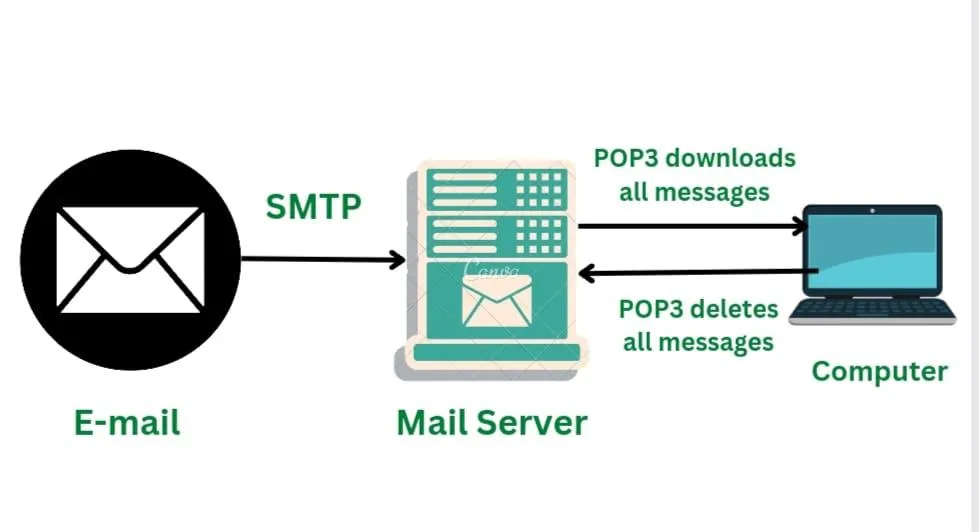
The POP Protocol is designed to make email management efficient and user-friendly. Here are some of its key features:
Reduces Server Load: By downloading emails to your device, POP3 minimizes the amount of data stored on the email server, utilizing less server storage space, which can help with server performance and storage issues.
Offline Access: It enables users to access their email messages without an internet connection, providing flexibility for users on the go or with unreliable internet access.
Security: Through encrypted communication protocols like Transport Layer Security (TLS), POP3 ensures the secure transfer of emails, protecting user privacy and data integrity.
Flexibility: Users can configure their email client to either delete messages from the server after download or keep a copy, allowing for flexibility in managing server storage and local access.
How POP Protocol Works
Understanding the workings of the Post Office Protocol version 3 (POP3) is essential for anyone relying on email communication. Here's a step-by-step breakdown of the POP3 process
1. Establishes Connection
- Start: The email client initiates the process by connecting to the mail server, specifically targeting the POP3 port. The standard ports are 110 for unencrypted connections and 995 for secure connections using POP3S (encrypted communication).
- Server Response: Upon connection, the remote mail server acknowledges and indicates readiness for the next step, setting the stage for user authentication.
2. User Authentication
- Authentication Request: The user's credentials, including the username and password, are sent from the client machine to the email server. This step is crucial for ensuring that only authorized users can access their email account.
- Server Validation: The server examines the provided credentials. If validated, access is granted, allowing the email client to proceed to email retrieval.
3. Retrieves Emails
- Checking Messages: The email client requests a list of new messages. In response, the server provides the count of new email messages and their cumulative size, offering insight into the mail retrieval task ahead.
- Downloading Messages: Using the RETR command followed by the specific message number, the client proceeds to download each email. This phase is pivotal, as it transitions the email content from the remote server to the local computer for offline access.
- Marking for Deletion: Depending on the email client's configuration, messages can be marked for deletion post-download using the DELE command. This step is optional, with some configurations opting to leave a copy on the server for access from other devices or email clients.
4. Session Termination
- Closing the Session: After downloading the desired messages, the client issues a QUIT command, signaling the end of the session.
- Finalizing Actions: The server then executes any pending deletion commands, effectively removing emails marked for deletion, and concludes the session by severing the connection.
5. Offline Access
- Local Storage: The emails, now downloaded, are stored on the local machine, such as a personal computer or laptop. This allows the user to access, read, and manage their emails without the need for an active internet connection, enhancing email accessibility and convenience.
Exploring Other Key Email Protocols
Beyond POP Protocol, the digital communication landscape is supported by two critical protocols: Simple Mail Transfer Protocol (SMTP) and Internet Message Access Protocol (IMAP). Each serves a distinct function in email transmission and management, essential for efficient digital correspondence.
Simple Mail Transfer Protocol
SMTP is the engine behind email sending. When you send an email, SMTP takes charge, ensuring your message is delivered from your email client to the recipient's email server.
- Functionality: SMTP uses a "push" method, where your email client sends the message to an SMTP server, which then forwards it to the appropriate recipient's server.
- Essential for Email Sending: SMTP's role is pivotal; without it, emails would not move beyond your outbox.
- Configuration: Proper SMTP setup involves specifying the server address and port number, typically 25 for standard connections or 587 for secure submissions.
Internet Message Access Protocol
IMAP is used for accessing email messages on a mail server from a local client. Unlike POP3 (Post Office Protocol version 3), IMAP is designed for managing emails directly on the server.
- Synchronized Email Access: With IMAP, emails stay on the server, allowing you to interact with them from any device, keeping your inbox consistent across platforms.
- Ideal Use Cases: IMAP is suited for users who switch between devices to access their email and prefer managing their emails directly on the server, saving local storage space.
For more insights on SMTP, IMAP, and POP, explore our blog - What is SMTP? Decoding Differences SMTP vs IMAP vs POP3
Choosing the Right Protocol: POP3 vs. SMTP vs. IMAP

Selecting the appropriate email protocol can significantly impact your email management efficiency. Whether you're toggling between multiple devices or relying on a single workstation, understanding the nuances of Internet Message Access Protocol (IMAP), Post Office Protocol version 3 (POP3), and Simple Mail Transfer Protocol (SMTP) is crucial.
SMTP, POP, and IMAP are Internet standard protocol used for email communication. Each protocol serves a different purpose in the email delivery and retrieval process
For Multiple Devices and Frequent Access
For those who use various devices to access their email — such as a smartphone, tablet, and laptop — IMAP stands out as the optimal choice.
It excels in synchronizing your email activities across all devices, maintaining the read/unread status, and ensuring that your mailbox is organized consistently, irrespective of the device you're using.
This seamless synchronization is especially beneficial for users who require real-time access to their email communication across different platforms.
For Single Device Access with Offline Needs
If your email checking is predominantly done through a single device and you have a need for offline access, POP3 is your ally.
It downloads email messages directly to your device, making them accessible even in the absence of an internet connection.
This feature of POP3 is particularly useful for individuals who prefer or need to manage their emails without constant internet connectivity, providing a reliable way to retrieve e mail and access important communications at any time.
For Sending Emails
Independent of whether POP3 or IMAP is chosen for receiving emails, SMTP is indispensable for sending emails.
This protocol is responsible for the outgoing email functionalities, working in tandem with either POP3 or IMAP.
SMTP ensures that your emails are successfully sent from your email client to the recipient's email server, making it a critical component of the email transmission process.
For Server Storage Considerations
Server storage is another important factor to consider when choosing between POP3 and IMAP.
POP server is often favored by those looking to minimize server storage usage, as it typically removes emails from the server after downloading them to your local device.
On the other hand, IMAP requires more server storage space since it retains all emails and folders on the server to allow for multi-device synchronization and access.
This distinction is crucial for users and organizations mindful of their server storage capacity and management.
How to Configure POP3 to Access Your Emails in Different Email Clients
Configuring POP3 (Post Office Protocol version 3) in various email clients allows you to download your internet mail from the server to your local computer, enabling offline access and management.
Here’s a general guide to set up POP3 across different email clients:
Steps to Read Your Email Messages on Other Email Client Using POP3:
1. Open Your Email Client:
- Launch the email client where you want to add your email account.
2. Access Account Settings:
- Look for 'Account Settings', 'Email Accounts', or a similar option, usually found under 'Tools', 'File', or 'Settings' menus.
3. Add a New Email Account:
- Choose to add a new email account and select the option to manually configure server settings or additional server types if prompted.
4. Choose POP3:
- When asked for the account type, select 'POP3'.
5. Enter Your Email Information:
- Email Address: Your full email address.
- Password: The password associated with your email account.
6. Configure Server Settings:
- Incoming Mail Server (POP3): This will vary depending on your email provider (e.g., 'pop.gmail.com' for Gmail).
- Outgoing Mail Server (SMTP): Also provider-dependent (e.g., 'smtp.gmail.com' for Gmail).
7. Specify Port Numbers:
- POP3 Port: Typically 995, this should be set with encryption (SSL) enabled.
- SMTP Port: Often 587 with TLS encryption, or 465 for SSL.
8. More Settings:
- Check or enter additional settings if needed, such as your full email address as the username.
- Under 'Outgoing Server', you might need to select 'My outgoing server (SMTP) requires authentication'.
Test the Configuration:
- Save the settings and, if available, use the 'Test Account Settings' feature to ensure everything is configured correctly.
Finish Setup:
- Complete the setup process and start receiving emails through your email client.
Specific Instructions for Popular Email Clients:
In Microsoft Outlook:
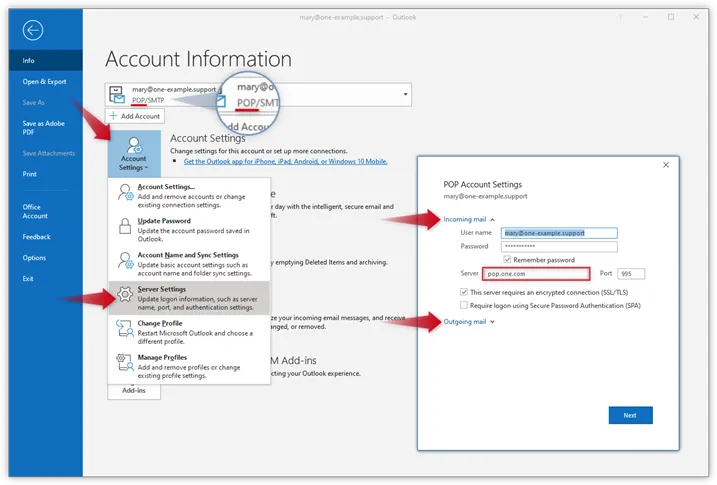
- Go to 'File' > 'Add Account' > 'Manual setup or additional server types'.
- Enter your email details and choose 'POP3'. Use outlook.office365.com for the incoming server if using Outlook email.
In Mozilla Thunderbird:
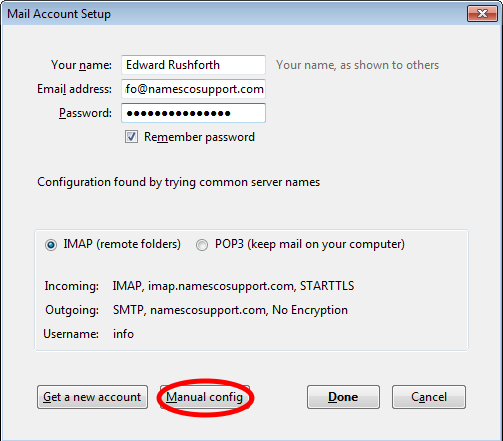
- Choose 'Email' under 'Create a new account'. Manually enter your email details when prompted and select 'POP3' as the server type.
In Apple Mail:
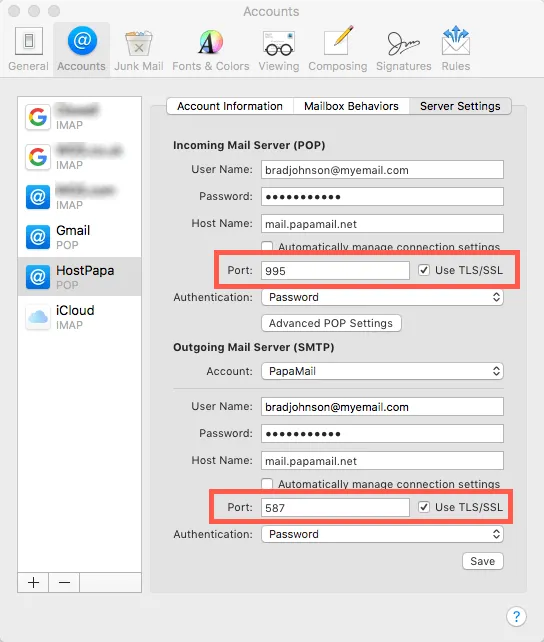
- Go to 'Mail' > 'Add Account', choose 'Other Mail Account...', and manually input your email settings, selecting 'POP' as the account type.
In Gmail (to access another account within Gmail):

- Click the gear icon > 'See all settings' > 'Accounts and Import' > 'Add a mail account'. Enter your email details and select 'Import emails from my other account (POP3)'.
How to Optimize Email Retrieval with POP Protocol
Optimizing email retrieval with the Post Office Protocol (POP) involves configuring your email client settings to balance between performance, convenience, and server resource usage.
POP, specifically designed for downloading emails from your mail server to your local computer, offers significant flexibility in how you manage your emails. Here’s how you can optimize this process:
1. Choose the Right Version of POP
- POP3: The most recent version, POP3, is widely supported and offers various options for managing your emails, such as whether to keep a copy of your emails on the server after downloading them.
2. Configure Email Download Settings
- Selective Download: Some email clients allow you to specify criteria for which emails should be downloaded (e.g., only emails under a certain size or only messages from the last few days). This can speed up email retrieval and save local storage space.
- Leave Messages on Server: If you access your email from multiple devices but prefer using POP for its simplicity and offline access, consider configuring your email client to leave messages on the server for a certain period. This way, you can download the same emails on different devices.
3. Manage Local Storage
- Regular Cleanup: Regularly archive or delete old emails from your local storage to keep your email client running smoothly. Consider backing up important emails to an external hard drive or cloud storage.
- Compact Folders: Many email clients store emails in a database. Compacting these databases can reclaim space and improve performance.
4. Schedule Email Retrieval
- Peak and Off-Peak Hours: Configure your email client to download emails during off-peak hours if you have a slow or metered internet connection. This minimizes disruptions during high-usage periods.
- Manual Retrieval: For even greater control, especially if you receive a high volume of emails, consider setting your email client to manual mode, so it only checks for new emails when you explicitly request it.
5. Use Secure Connections
- SSL/TLS Encryption: Ensure that your email client is configured to use SSL (Secure Sockets Layer) or TLS (Transport Layer Security) when retrieving emails. This encrypts the connection between your email client and the mail server, protecting your emails from being intercepted.
6. Optimize SMTP Settings for Sending Emails
- While POP is used for receiving emails, SMTP is used for sending them. Ensure your SMTP settings are optimized by:
- Enabling “My outgoing server (SMTP) requires authentication,” which is typically necessary for sending emails.
- Using the correct SMTP port (usually 587 for TLS or 465 for SSL) to ensure reliable email sending.
7. Regularly Update Your Email Client
- Software Updates: Keep your email client updated to the latest version to benefit from improved features, performance optimizations, and security patches.
8. Monitor Email Client Performance
- Performance Issues: If your email client starts to slow down or behaves erratically, it might be time to review your settings or consider archiving old emails to external storage.
Common POP3 Issues and Solutions
Understanding these common issues and their solutions can significantly enhance your email management experience.
1. Connection Problems
- Issue: Failure to connect to the POP3 server, often indicated by error messages like "Cannot connect to the POP3 server" or "Server not found."
- Solution: Verify your email client's settings to ensure the correct POP3 server address (e.g., pop.gmail.com for Gmail) and port number (usually 995 for SSL-encrypted connections) are used. Also, check your internet connection and firewall settings to ensure they're not blocking access to the email server.
2. Authentication Errors
- Issue: Incorrect username or password errors, often due to changes in the email account credentials that haven't been updated in the email client.
- Solution: Re-enter your account credentials in the email client settings, ensuring the username (typically your full email address) and password are correct. If the problem persists, reset your email account password and update it in your email client.
3. Email Synchronization Issues
- Issue: Emails not appearing in the email client or being deleted from the server unexpectedly.
- Solution: Adjust the POP3 settings in your email client to either leave a copy of emails on the server or to download emails without removing them. This is crucial for accessing your emails across multiple devices.
4. SSL/TLS Encryption Errors
- Issue: Security warnings or failure to securely connect to the email server, possibly due to outdated encryption protocols.
- Solution: Ensure that your email client is configured to use SSL/TLS encryption for POP3 connections. Check for updates for your email client to support the latest security standards.
5. Incomplete Email Downloads
- Issue: Only parts of emails are downloaded, or attachments are missing.
- Solution: Increase the server timeout settings in your email client to allow more time for emails to be downloaded, especially if they contain large attachments or if you have a slow internet connection. Also, check if your email client has settings that limit the size of downloaded emails and adjust accordingly.
6. SMTP Configuration for Outgoing Emails
- While POP3 handles incoming emails, issues with sending emails are often related to the Simple Mail Transfer Protocol (SMTP) settings.
- Solution: Verify that your email client's SMTP settings are correctly configured with the right SMTP server address (e.g., smtp.gmail.com for Gmail users), port (typically 587 for TLS), and ensure that "My outgoing server (SMTP) requires authentication" is enabled.
7. Receiving Duplicate Emails
- Issue: The same emails are downloaded multiple times, leading to duplicates in your email client.
- Solution: This can occur if your email client is set to not remove messages from the server after downloading. Check your POP3 settings to ensure they align with your email management preferences, and consider using the "recent mode" (recent:yourusername@gmail.com in Gmail) if accessing emails from multiple clients.









